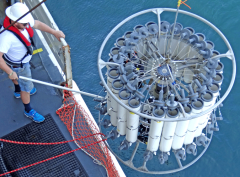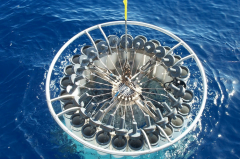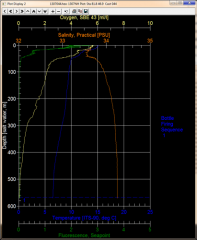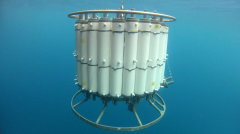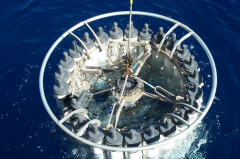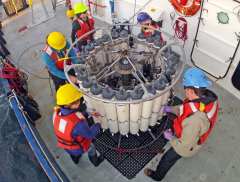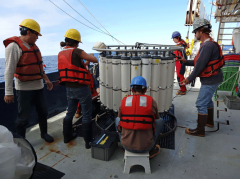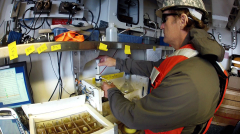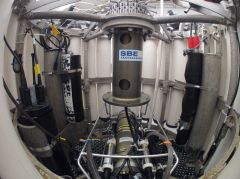CalCOFI employs some routine practices to keep our CTD generating the best data possible. This page summarizes some of the common practices and recommendations.
Background
SIO-CalCOFI has deployed a Seabird 911 CTD since early 1990, with Seabird techs, early on fine-tuning the system on RV New Horizon CalCOFI cruises. Initially, the system was passive flow, not pumped which generated a lot of noise as the ship rolled. Once Seabird developed an inline pump that stabilized the movement of seawater through the system regardless on wire speed or ship roll. The data quality improved so much that CalCOFI replaced hanging individual sampling bottles on wire with a 24-bottle CTD-rosette. Still, the conversion was gradual, with the CTD-rosette initially replacing only the daily 6-bottle primary productivity cast. The reliability of using computers in 1990-1993 tethered to electronic instrumentation via conductive winch wire needed thorough testing. After sea trials on several cruises over three years, CalCOFI adopted the CTD-rosette for all station work on CalCOFI 9308NH.
CTD standard practices have evolved over the last 25 years especially with improvements in sensor technology and computer software & processing power. Actually, the core CTD & sensor hardware has not changed that much except in response time. But new sensors such as profiling pH and ISUS-Nitrate sensors have expanded our suite of measurements
Practices
CTD Sensor Calibration & Upkeep - in the past, we would routinely send our sensors to Seabird for calibration every six months - after every two cruises. Although Seabird typically recommends annually servicing sensors, we felt the performance of the sensors was critically important. With the overall cost of cruises, it's a relatively small expense to send in our sensors every 6mos. The cost and turn-around time has been increasing each year so, overtime, the six month/two cruise practice has softened. As predicted by Seabird, temperature sensors are very reliable and annual calibrations are probably adequate. Same with conductivity sensors although I am less confident they can go an entire year. Fortunately CalCOFI collects seawater samples to calibrate any drift over time. More on this later but the point being, if you take seawater samples that can be used to calibrate your sensors, servicing sensors may be done less often.
Our current standard sensor deployment practice is to rotate our sensors from primary to secondary after two cruises if they are performing up to our standard (agreement with calibration samples).
- A freshly calibrated temperature sensor is installed on a cruise, along with a fresh conductivity and oxygen sensor, plumbed inline with a pump. If the sensor array perform well for the entire cruise, usually 75-105 casts, they stay mounted as primaries for the next cruise.
- After two cruises, if the primary sensor array still agrees well with bottle samples or, at least, have a consistent offset, they become the secondary sensor array (CalCOFI runs dual T, C, O2 arrays).
- The secondary sensors are removed and, time-permitting (based on the amount of time between cruises), are sent in for service and calibration. CalCOFI has three sets of sensors so there are always a spare set at sea to replace failing sensors.
- New primary temperature, conductivity, and oxygen sensors are installed. They stay as primary for two cruises and if still performing well, are shifted to secondary. And the rotation cycle continues...
- If a sensor stops working or start generating questionable data, it is removed and replaced with a spare if possible.
- Both primary & secondary sensor arrays are flushed with DI water after every cast to reduce biofouling and keep sensors performing well.
- At the end of the cruise, a dilute solution of Triton or ABS flushes the system, stay in the system plumbing for 30-60mins, then is thoroughly flushed out with DI water for storage. DI water flushes are performed periodically between cruises to keep the sensor wet.
CalCOFI performs seawater sample analyses at-sea so have the luxury of relatively quick & numerous data quality checks. The data acquisition & processing software compares CTD preliminary data to bottle data so problems can be identified quickly. I would recommend, if you do not collect seawater calibration samples to be extra vigilant monitoring the sensor data. Hopefully, you can run two sets and check agreement between primary and secondary T, S, & O2. If you can only run a single set of sensors, I would recommend calibrating your conductivity and oxygen (SBE43) sensors more frequently since they are much more sensitive than temperature sensors. Oxygen optode sensors are recommended if oxygen bottle samples are not collected.
Pylon Carousel
CalCOFI uses Seabird SBE32 24-trigger pylons. When mistrips occur, we perform trigger maintenance and replacement to avoid switching pylons. A freshwater deck hose is used to throughly rinse the carousel crown after each cast to minimize biofouling between casts.
- Trigger maintenance and rebuilding are common practices and performed before each cruise.
- Spare triggers - either new or rebuilt - are kept on-hand at-sea so they can easily replace unreliable triggers.
- Usually, if a bottle mistrips, the trigger will be cleaned with a Q-Tip, checking for biofouling, rust or paint chips.
-
If it mistrips consecutively more than once after servicing or lanyard re-rigging, the trigger is replaced.
- First, inspect the lanyard rigging and change it if potentially the problem. Rigging the lanyard on the left of right side of the bottle can change the lanyard's angle to the trigger; pulling the trigger offcenter can cause the trigger to bind so rigging the lanyard as true as possible to the trigger throw will improve reliability.
- Second, if the lanyard rigging does not appear to be the problem, remove the carousel "crown", disassemble and install a new trigger, replacing the unreliable one. Reassemble and carefully reinstall the crown and test. If the problem persists, or you do not feel comfortable disassembling the crown. You can swap the entire crown with the backup pylon's crown or swap pylons.
CTD "Fish"
SIO-CalCOFI deploys a 24-10L bottle epoxy-coated CTD-rosette on all stations. The SBE9+ "fish" is mounted horizontally on the lower rosette frame using stainless steel hose-clamps. The dual pumped T, C, O2 sensor arrays are mounted horizontally on opposing sides of the anodized CTD case. The two pumps are configured so their exhaust ports are roughly the same level as the temperature sensor intakes. This is important to minimize any pressure differential between intake and output when moving through the water column at 60m/min.
Our regular deployment practice is to start data acquistion by powering the deck unit ON while the system is still on deck, logging deck pressure. The CTD-rosette is then deploy it into the ocean, send it down 10m to compress & blow the air out of the tubing. The pumps are powered on when seawater contacts the primary conductivity sensor after ~45secs. It is important to monitor the pump status in Seasoft and not start data acquisition unless the pumps are running. After 2 mins at 10m and the pump status reads "ON", the CTD-rosette is brought back to "just below surface", usually ~2m if conditions permit. Avoid the roseete popping out of the water during bigger ship rolls or else the pumps will turn off and you'll have to repeat the 10m dip. Once at surface, data archiving is initiated in Seasoft, noisy screen plot profiles erased, and ~45-60secs of data acquired. If everything looks good, sensor pairs agree, the CTD-rosette is send to terminal depth (usually 515m, depth permitting or within 10m of bottom). The winch speed is 30m/min for the first 100m then, weather/sea state permitting, increased to 60m/min to terminal depth. The sensors are optimized for 60m/min (1m/sec) so be sure not to go faster than that.


